
John Wesley Powell was an American geologist, U.S. Army soldier, explorer of the American West, professor at Illinois Wesleyan University, and director of major scientific and cultural institutions. He is famous for his 1869 geographic expedition, a three-month river trip down the Green and Colorado rivers, including the first official U.S. government-sponsored passage through the Grand Canyon.
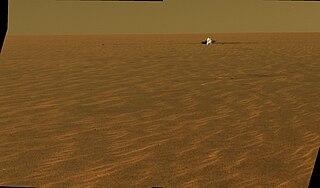
The Meridiani Planum (alternately Meridiani plain, Meridiani plains, Terra Meridiani, or Terra Meridiani plains) is either a large plain straddling the equator of Mars and covered with a vast number of spherules containing a lot of iron oxide or a region centered on this plain that includes some adjoining land. The plain sits on top of an enormous body of sediments that contains a lot of bound water. The iron oxide in the spherules is crystalline (grey) hematite (Fe203).
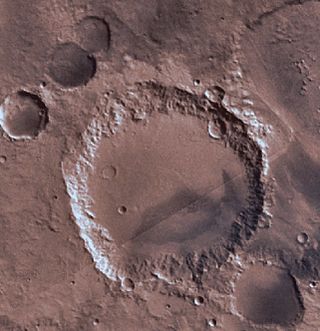
Beer is a crater lying situated within the Margaritifer Sinus quadrangle (MC-19) region of the planet Mars, named in honor of the German astronomer, Wilhelm Beer. It is located at 14.4°S 351.8°E.

Mädler is a crater on Mars. It was named in honor of the German astronomer Johann Heinrich Mädler by the IAU in 1973.

Endurance is an impact crater lying situated within the Margaritifer Sinus quadrangle (MC-19) region of the planet Mars. This crater was visited by the Opportunity rover from May until December 2004. Mission scientists named the crater after the ship Endurance that sailed to the Antarctic through the Weddell Sea during the ill-fated 1914-1917 Imperial Trans-Antarctic Expedition, considered to be the last expedition of the Heroic Age of Antarctic Exploration organized by Ernest Shackleton.
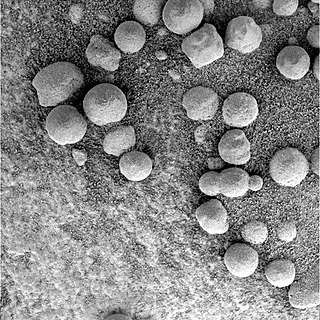
Martian spherules (also known as hematite spherules, blueberries, & Martian blueberries) are small spherules (roughly spherical pebbles) that are rich in an iron oxide (grey hematite, α-Fe2O3) and are found at Meridiani Planum (a large plain on Mars) in exceedingly large numbers.

Victoria is an impact crater on Mars located at 2.05°S, 5.50°W in the Meridiani Planum extraterrestrial plain, lying situated within the Margaritifer Sinus quadrangle (MC-19) region of the planet Mars. This crater was first visited by the Mars Exploration Rover Opportunity. It is roughly 800 metres (2,600 ft) wide, nearly eight times the size of the crater Endurance, visited by Opportunity from sols 951 to 1630. It is informally named after Victoria – one of the five Spanish ships of Ferdinand Magellan and the first ship to circumnavigate the globe – and formally named after Victoria, Seychelles. Along the edges of the crater are many outcrops within recessed alcoves and promontories, named for bays and capes that Magellan discovered.

Erebus is a crater lying situated within the Margaritifer Sinus quadrangle (MC-19) region of the planet Mars, this extraterrestrial geological feature was visited by the Opportunity rover on the way to the much larger crater Victoria. It is named after the polar exploration vessel HMS Erebus which was used by James Clark Ross in 1841 to discover the Great Ice Barrier, now known as the Ross Ice Shelf. The rover was in the immediate vicinity of the crater from approximately sol 550 to 750.

Beagle is a crater lying within the Margaritifer Sinus quadrangle (MC-19) portion of the planet Mars, the crater is one of multiple topographical depressions within the Meridiani Planum extraterrestrial plain, which was explored by the Opportunity rover. It was located by the rover in images taken on sol 855, 310 metres (1,107 ft) away. It is on the edge of the much larger ejecta blanket surrounding the crater Victoria, named the Victoria Annulus. This impact crater was named in honor of HMA Beagle of the Royal Navy, ordered in February 1817, which carried Charles Darwin on his voyage round the world.
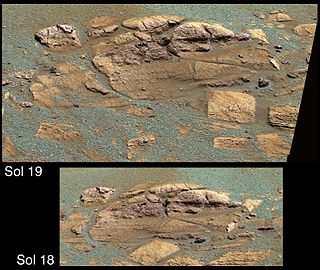
El Capitan is a layered rock outcrop found within the Margaritifer Sinus quadrangle (MC-19) region of the planet Mars, this geological outcrop was first discovered and observed by the Mars Exploration Rover Opportunity in February 2004. The rock outcrop was named for El Capitan, a topographical mountain lying within the state of Texas.

The geology of Mars is the scientific study of the surface, crust, and interior of the planet Mars. It emphasizes the composition, structure, history, and physical processes that shape the planet. It is analogous to the field of terrestrial geology. In planetary science, the term geology is used in its broadest sense to mean the study of the solid parts of planets and moons. The term incorporates aspects of geophysics, geochemistry, mineralogy, geodesy, and cartography. A neologism, areology, from the Greek word Arēs (Mars), sometimes appears as a synonym for Mars's geology in the popular media and works of science fiction. The term areology is also used by the Areological Society.

Ten Who Dared is a 1960 American Western film directed by William Beaudine and starring Brian Keith, Ben Johnson, John Beal and James Drury. It was produced by Walt Disney Productions and released by Buena Vista Distribution. It tells the story of United States Army officer John Wesley Powell, who was the first to travel down the Colorado River, and the dangers that he and nine other men had to face while making a map of the region during their 1869 expedition. Hired by Walt Disney Studios in 1959 as a technical adviser, Otis R. Marston led a film crew through the Grand Canyon to film river running and background scenes for the film.

Endeavour is an impact crater located in the Meridiani Planum extraterrestrial plain within the Margaritifer Sinus quadrangle (MC-19) region of the planet Mars. Endeavour is about 22 kilometers (14 mi) in diameter. Using Mars Reconnaissance Orbiter data, phyllosilicate-bearing outcrops have been detected along its rim. These minerals may have formed under wet conditions in a low-acidic environment during the early history of Mars. There are raised rim segments to the north, east, and southwest. The rim has become worn, rounded and degraded, with infilling of plains material in a manner similar to the Victoria crater.
Santa Maria is an impact crater on Mars, located at 2.172°S, 5.445°W within the Meridiani Planum extraterrestrial plain, lying situated within the Margaritifer Sinus quadrangle (MC-19) region.

Rain and snow was a regular occurrence on Mars in the past; especially in the Noachian and early Hesperian epochs. Water was theorized to seep into the ground until it reached a formation that would not allow it to penetrate further. Water then accumulated forming a saturated layer. Deep aquifers may still exist.

Matijevic Hill, named after American NASA engineer Jacob "Jake" Matijevic, is a hill located on "Cape York", itself on the western rim of Endeavour Crater lying within the Margaritifer Sinus quadrangle (MC-19) region of the planet Mars. It was discovered by the Opportunity rover, and named by NASA on September 28, 2012. The "approximate" site coordinates are: 2.22923°S 5.35068°W.

Opportunity is a robotic rover that was active on the planet Mars from 2004 to 2018. Launched on July 7, 2003, Opportunity landed on Mars' Meridiani Planum on January 25, 2004, at 05:05 Ground UTC, three weeks after its twin Spirit (MER-A), also part of NASA's Mars Exploration Rover Mission, touched down on the other side of the planet. While Spirit became immobile in 2009 and ceased communications in 2010, Opportunity exceeded its planned 90 sol duration of activity by 14 years 46 days. Opportunity continued to move, gather scientific observations, and report back to Earth until 2018. What follows is a summary of events during its continuing mission.
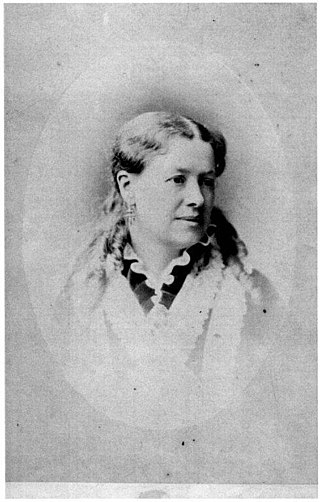
Harriet Emma Dean Powell was a botanist and ornithologist, and the wife of John Wesley Powell. She accompanied and cared for him after the loss of his arm during the Civil War and was with him during many of his trips to explore the Western United States serving as a scientific assistant collecting samples. John Wesley Powell's personal vessel for the 1869 Powell Geographic Expedition was named the Emma Dean in her honor.

















